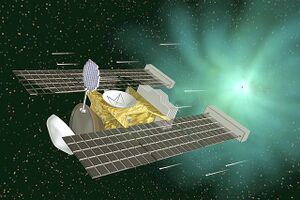Stardust (spacecraft) (nonfiction)
Stardust was a 300 kilogram robotic space probe launched by NASA on 7 February 1999. Its primary mission was to collect dust samples from the coma of comet Wild 2, as well as samples of cosmic dust, and return these to Earth for analysis.
En route to comet Wild 2, the craft also flew by and studied the asteroid 5535 Annefrank.
At 19:21:28 UTC, on 2 January 2004, Stardust encountered comet Wild 2 on the sunward side with a relative velocity of 6.1 km/s at a distance of 237 km (147 mi). The original encounter distance was planned to be 150 km (93 mi), but this was changed after a safety review board increased the closest approach distance to minimize the potential for catastrophic dust collisions.
The relative velocity between the comet and the spacecraft was such that the comet actually overtook the spacecraft from behind as they traveled around the Sun. During the encounter, the spacecraft was on the Sunlit side of the nucleus, approaching at a solar phase angle of 70 degrees, reaching a minimum angle of 3 degrees near closest approach and departing at a phase angle of 110 degrees.
During the flyby the spacecraft deployed the Sample Collection plate to collect dust grain samples from the coma, and took detailed pictures of the icy nucleus.
At 05:57:00 UTC on 15 January 2006, the Sample Return Capsule successfully separated from Stardust and re-entered the Earth's atmosphere at 09:57:00 UTC, at a velocity of 12.9 km/s, the fastest reentry speed into Earth's atmosphere ever achieved by a man-made object.
A subsequent mission extension to bring the spacecraft back to full operation for a flyby of comet Tempel 1, codenamed NExT, was approved on 3 July 2007.
At 04:42:00 UTC on 15 February 2011, Stardust-NExT encountered Tempel 1 from a distance of 181 km (112 mi). An estimated 72 images were acquired during the encounter. These showed changes in the terrain and revealed portions of the comet never seen by the Deep Impact spacecraft. The impact site from Deep Impact was also observed, though it was barely visible due to material settling back into the crater.
On 24 March 2011, Stardust conducted a burn to consume its remaining fuel. The spacecraft had little fuel left and scientists hoped the data collected would help in the development of a more accurate system for estimating fuel levels on spacecraft. After the data had been collected, no further antenna aiming was possible and the transmitter was switched off. The spacecraft sent an acknowledgement from approximately 312,000,000 kilometers (194,000,000 mi) away in space.
On 14 August 2014, scientists announced the identification of possible interstellar dust particles from the Stardust capsule returned to Earth in 2006.
In the News
Fiction cross-reference
Nonfiction cross-reference
External links:
- Stardust (spacecraft) @ Wikipedia
